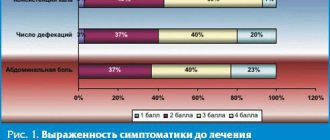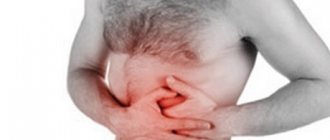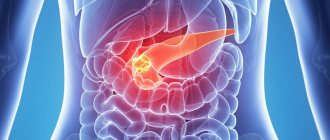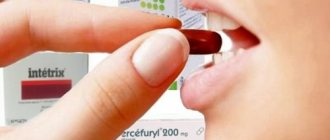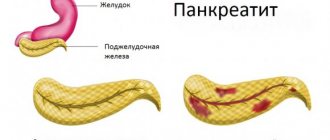Antisecretory drugs in the complex treatment of acute pancreatitis
Acute pancreatitis is an acute aseptic inflammation of the pancreatic tissue of the demarcation type, which is based on acute dystrophy, enzymatic autoaggression with necrobiosis of pancreatocytes and subsequent outcome in necrosis of the glandular tissue and surrounding structures with the addition of an endogenous secondary purulent infection or in sclerosis of the pancreas with atrophy of its glandular apparatus .
In a modern emergency surgery clinic, acute pancreatitis ranks third in the number of emergency hospitalized patients, second only to acute appendicitis and acute cholecystitis. Despite the constant improvement of treatment tactics and the introduction of new diagnostic and treatment technologies, over the last decade, mortality in acute pancreatitis ranges from 7-15%, and in destructive forms of pancreatitis reaches 40-80%.
To date, a colossal number of works have been published on the problem of acute pancreatitis. However, until now, most of the provisions regarding the etiology, pathogenesis, classification and treatment tactics for this pathology remain highly controversial. It is generally accepted that acute pancreatitis is a polyetiological disease. At the same time, American authors consider alcohol abuse to be its main cause, German authors consider cholelithiasis, Chinese and Vietnamese authors consider ascariasis. However, traditionally there are two groups of etiological factors for this disease. The first group includes factors that determine the disruption of the outflow of pancreatic secretions from the acini along the intralobular ducts into the main pancreatic duct and further into the duodenum, which leads to a sharp increase in pressure in the ductal system of the pancreas (hypertension-ductal factors). Intraductal hypertension occurs with spasm, inflammatory, cicatricial and neoplastic stenoses of the major duodenal papilla, including the sphincter of Oddi, and choledocholithiasis. Spasm of the sphincter of Oddi can be a consequence of both various neuro-reflex influences from the receptors of the hepatogastroduodenal zone, and direct irritation of the sympathetic and parasympathetic parts of the nervous system. Excitation of the vagus nerve causes hypersecretion of pancreatic juice, spasm of the sphincter of Oddi, and the occurrence of stasis and hypertension in the pancreatic duct system. It has been established that long-term consumption of alcohol in relatively large doses directly causes an increase in pressure in the small ducts of the pancreas. Etiological factors belonging to the second group lead to primary damage to acinar cells under conditions of normal intraductal pressure (primarily acinar factors). It is known that primary damage to pancreatic acinar cells can occur with local hemoperfusion disorders, allergic reactions, metabolic disorders, hormonal imbalance, toxic effects, infections, and trauma to the pancreas. The role of the nutritional etiological factor of acute pancreatitis can be reduced to the following. Foods rich in proteins and fats, alcohol cause pronounced secretion of pancreatic juice, rich in protein and poor in bicarbonates, which, if there is inadequate outflow, can cause the development of alimentary pancreatitis. Enhanced secretory activity of acinar cells with excessive food irritations or when eating protein-poor food is accompanied by irreversible intracellular damage to the acinar apparatus and the development of metabolic pancreatitis. It has been noted that excessive consumption of protein-rich foods can lead to sensitization of the body with protein metabolites, which leads to the development of allergic pancreatitis. Thus, the main etiological factors of acute pancreatitis can be called the following: cholelithiasis, pathology of the terminal part of the common bile duct and BDS, alcohol abuse , injuries (including operating rooms) of the pancreas, vascular diseases, metabolic disorders, infections, intoxications, autoallergic conditions. It has been experimentally shown and clinically confirmed that the most severe forms of acute pancreatitis develop with a combination of three etiological factors:
pancreatic hypersecretion;
acute intraductal hypertension;
intratubular activation of pancreatic enzymes.
The pathogenesis of acute pancreatitis currently also remains the subject of heated debate. It is believed that the development of acute pancreatitis is caused by a violation of the intracellular formation and transport of pancreatic enzymes, as well as intraacinar activation of proenzymes by hydrolases. The triggering mechanism for pathological reactions, which are the basis of inflammatory-necrotic damage to the pancreas, is the release of activated pancreatic enzymes from acinar cells, which are normally present in the form of inactive proenzymes. At the same time, today it is generally accepted that the processes of autolysis are primarily caused by the action of lipolytic enzymes. Activation of lipases occurs when the latter's proenzymes come into contact with bile acids and enterokinases. This situation occurs with hydraulic destruction of the acini due to intraductal hypertension, which is mainly a consequence of pancreatic hypersecretion and biliary-pancreatic or duodenopancreatic reflux with stenosis or insufficiency of the sphincter of Oddi and duodenal hypertension. It is assumed that alcohol not only has a direct toxic effect on pancreatocytes, but also causes the formation of protein microconglomerates that occlude small pancreatic ducts. Note that pancreatic lipase does not damage a healthy cell. The damage is caused by the action of phospholipase A, leading to the destruction of cell membranes, which makes it possible for lipase to penetrate the cell. When this mechanism is implemented, loci of fatty pancreatic necrobiosis with a perifocal demarcation shaft are formed. If the pathobiochemical process is limited to this, then fatty pancreatic necrosis is formed. If, due to excessive accumulation of fatty acids in the gland tissue, the pH reaches 3.4-4.3, intracellular trypsinogen is transformed into trypsin. In this case, trypsin activates lysosome proenzymes, as well as other proteinases that cause proteolysis of pancreatocytes. Activated elastase lyses the walls of blood vessels and interlobular connective tissue bridges, which contributes to the rapid spread of enzymatic autolysis in the pancreas and surrounding structures. Under the influence of trypsin, all pancreatic proenzymes (elastase, carboxypeptidases, chymotrypsin proenzyme), proenzymes of the kallikrein-kinin system, fibrinolytic enzymes and hemocoagulation profactors are activated, which ultimately leads to local and general pathobiochemical disorders with a possible outcome in the form of multiple organ failure syndrome . It is customary to distinguish a pre-infectious stage of the disease, in which aseptic inflammatory and necrotic foci are formed, and a phase of infectious complications - infected pancreatic necrosis, infected pancreatic necrosis with pancreatogenic abscess, retroperitoneal phlegmon.
Thus, one of the fundamental aspects of the complex of pathological reactions united by the concept of “acute pancreatitis” is intraductal hypertension in the pancreas. In this case, the main component of the increase in intraductal pressure is the secretion (in some situations - hypersecretion) of pancreatic juice.
The traditional classification of acute pancreatitis, accepted by practical surgeons, is a clinical and morphological classification that distinguishes acute edematous pancreatitis and destructive forms of pancreatitis - fatty pancreatic necrosis, hemorrhagic pancreatic necrosis, and also provides for the possible development of early and late complications. S. F. Bagnenko, A. D. Tolstoy, A. A. Kurygin (2004) distinguish the following clinical forms of acute pancreatitis, corresponding to the pathophysiological phase of its course:
Phase I is enzymatic and comprises the first five days of the disease. During this period, the formation of pancreatic necrosis of varying extent, the development of endotoxemia (the average duration of hyperfermentemia is 5 days), and in some patients - multiple organ failure and endotoxin shock. The maximum period for the formation of pancreatic necrosis is three days, after this period it does not progress further. However, with severe pancreatitis, the period of formation of pancreatic necrosis is much shorter (24-36 hours). It is advisable to distinguish two clinical forms: severe and non-severe acute pancreatitis.
- Severe acute pancreatitis. The incidence is 5%, mortality is 50-60%. The morphological substrate of severe acute pancreatitis is widespread pancreatic necrosis (large focal and total-subtotal), which corresponds to severe endotoxicosis.
- Mild acute pancreatitis. The incidence is 95%, mortality is 2-3%. Pancreatic necrosis in this form of acute pancreatitis either does not form (swelling of the pancreas) or is limited in nature and does not spread widely (focal pancreatic necrosis - up to 1.0 cm). Non-severe acute pancreatitis is accompanied by endotoxemia, the severity of which does not reach a severe degree.
Phase II is reactive (2nd week of the disease), characterized by the body’s reaction to the formed foci of necrosis (both in the pancreas and in the parapancreatic tissue). The clinical form of this phase is peripancreatic infiltrate.
Phase III – melting and sequestration (starts from the 3rd week of the disease, can last several months). Sequesters in the pancreas and retroperitoneal tissue begin to form from the 14th day from the onset of the disease. There are two possible options for the course of this phase:
- aseptic melting and sequestration – sterile pancreatic necrosis; characterized by the formation of postnecrotic cysts and fistulas;
- septic melting and sequestration - infected pancreatic necrosis and necrosis of parapancreatic tissue with further development of purulent complications. The clinical form of this phase of the disease is purulent-necrotic parapancreatitis and its own complications (purulent-necrotic leaks, abscesses of the retroperitoneal space and abdominal cavity, purulent omentobursitis, purulent peritonitis, arrosive and gastrointestinal bleeding, digestive fistulas, sepsis, etc.) .
It should be noted that not all authors share the point of view on the evolution of pathomorphological changes in acute pancreatitis and suggest the possibility of the occurrence of a primary destructive process (hemorrhagic pancreatic necrosis) without previous acute edematous pancreatitis and fatty pancreatic necrosis. This may be due to the fact that patients, due to a certain social background, are hospitalized already at the stage of hemorrhagic pancreatic necrosis or in the presence of purulent complications. However, most researchers support the opinion of the continuity of the morphological phases of acute pancreatitis. Thus, M. Schein (2004) calls pancreatitis “a disease of four weeks.” And this is quite understandable, both from the point of view of pathomorphology and from the pragmatic point of view of a practicing American surgeon. Indeed, the first two weeks are persistent complex conservative treatment, in the subsequent period - surgical interventions from minimally invasive (laparoscopy, transparietal punctures) to very aggressive (necrosequestrectomy, omentopancreatobursostomy, opening of pancreatogenic abscesses and phlegmon of the retroperitoneal space). Since in this section the author did not aim to continue the discussion about treatment tactics for acute pancreatitis (primarily about the indications, timing and scope of surgical treatment), the main attention is paid to the issue of conservative treatment of patients with this pathology. It should be noted that, according to a number of authors (A. D. Tolstoy, 2003, M. Schein, 2004), it is pathogenetically based complex conservative therapy for acute pancreatitis that is crucial for the outcome of the disease. This is especially true for acute edematous pancreatitis, since it prevents the transition of this form of pancreatitis to pancreatic necrosis. No less relevant is intensive conservative therapy for already formed foci of fatty or hemorrhagic destruction, which in this case prevents the spread of inflammatory-necrotic foci to previously intact tissue. In addition, taking into account the primary asepsis of the process in acute pancreatitis in the initial period of the disease, from the standpoint of common sense, it is advisable to take active therapeutic treatment aimed at stopping pathological processes in the pancreas itself, preventing and treating pancreatogenic toxemia syndrome, and preventing purulent-septic complications.
Currently, the fundamental principles of conservative treatment of acute pancreatitis are set out in all guidelines for emergency abdominal surgery. Let us remind the reader of them with some comments. So, for acute pancreatitis the following are indicated:
- Measures aimed at suppressing the exocrine function of the pancreas: A) “Cold, hunger and rest” (local hypothermia, strict diet, bed rest); B) Drug suppression of pancreatic secretion: cytostatics (5-fluorouracil, tegafur), inhibitors of gastric secretion (antisecretory drugs - H2 blockers, PPIs), opioid receptor agonists (dalargin), pancreatic ribonuclease, somatostatin and its synthetic analogues (octreotide).
- Antispasmodic therapy: myotropic antispasmodics (drotaverine, papaverine), anticholinergics (platiphylline, atropine), infusions of a glucose-novocaine mixture.
- Measures aimed at inactivating pancreatic enzymes circulating in the blood and inhibiting the cascade of reactions of the kallikrein-kinin system: protease inhibitors - aprotinin, ε-aminocaproic acid.
- Pain relief: non-steroidal anti-inflammatory drugs, opioid (with the exception of morphine, of course) analgesics, regional novocaine blockades.
- Correction of hypovolemic and water-electrolyte disorders, improvement of microcirculation, inhibition of free radical oxidation: infusions of crystalloids, colloids (hydroxystarch preparations, gelatins), perfluororganic emulsions, albumin, fresh frozen plasma, specific and nonspecific antioxidants.
- Detoxification therapy and methods of afferent detoxification: dextran infusions, forced diuresis, extracorporeal detoxification (hemo-, lympho- and enterosorption, plasmapheresis, ultrahemofiltration).
- Replenishment of energy costs (at least 3500 kcal/day): parenteral nutrition, balanced enteral tube nutrition.
- Correction of enteral insufficiency syndrome: prevention or relief of intestinal paresis, decompression of the small and large intestine, enteral lavage, use of enterosorbents, antihypoxants.
- Preventive prescription of antibacterial drugs: third generation cephalosporins, fluoroquinolones, metronidazole, in case of developed pancreatic necrosis - carbapenems (meropenem).
- Posyndromic therapy.
The works of various authors over the past five to ten years clearly show the evolution of treatment tactics in patients with acute pancreatitis from aggressive surgical to conservative expectant. The modern approach to the treatment of patients with acute pancreatitis dictates the need to select a specific therapy option, taking into account the stages of pancreatitis, taking into account the dynamics of laboratory parameters and instrumental research data - ultrasound, computed tomography, magnetic resonance imaging.
It should be noted that an indispensable condition for the treatment of patients with any clinical and morphological form of acute pancreatitis is compliance with the main condition - creating rest for the pancreas. This is achieved by suppressing the production of enzymes by pancreatocytes, as a result of which the release of enzymes that lyse proteins (trypsin, chymotrypsin, elastase) and phospholipid cell membranes (phospholipases, cholesterol esterase) is significantly reduced. Thus, the resting state of the pancreatocyte promotes regression of autolysis and prevents necrotic changes in tissue. In this regard, in the complex therapy of acute pancreatitis, the leading place is occupied by drugs that directly or indirectly inhibit the exocrine function of the pancreas. The maximum therapeutic effect is achieved by synergistically suppressing the synthesis of enzymes at the level of the pancreas, removing and inactivating enzymes already circulating in the blood.
Historically, the first class of compounds used for this purpose in acute pancreatitis were cytostatics - 5-fluorouracil, tegafur. The disadvantage of these drugs is the inhibition of leukopoiesis, impaired immunogenesis, and the occurrence of hypo- and dysproteinemia. The use of these drugs is justified in cases of verified pancreatic necrosis in order to maximally suppress the secretory function of the pancreas and thereby reduce the level of pancreatic enzymes in plasma. Previously, drugs of the protease inhibitor class were widely used to inhibit pancreatic secretion, but it has now been established that protease inhibitor drugs are active only in the blood. Protease inhibitors, as a rule, do not enter pancreatic tissue in sufficient concentrations and cannot effectively perform their function in relation to pancreatic juice enzymes. In addition, protease inhibitors have an autoimmunizing effect. To suppress the exocrine function of the pancreas, the use of opioid receptor agonists (dalargin), which selectively accumulate in pancreatocytes and inhibit the synthesis of pancreatic proenzymes, is justified. Pancreatic ribonuclease has a similar mechanism of action, destroying the messenger RNA of cells, thereby inhibiting protein synthesis by pancreatocytes. The drugs of choice for acute pancreatitis include a synthetic analogue of the hormone somatostatin, octreotide, which has a pronounced inhibitory effect on the exocrine function of the pancreas due to the activation of specific D-receptors of pancreatocytes. The main directions of its action are inhibition of basal and stimulated secretion of the pancreas, stomach, small intestine, regulation of the activity of the immune system, cytokine production, and cytoprotective effect. In addition, octreotide acts in the same way on the parietal and chief cells of the stomach, helping to reduce acid formation. The usual dosage regimen for octreotide is 300-600 mcg/day. with three times intravenous or subcutaneous administration.
A pathogenetically substantiated method of inhibiting pancreatic secretion is the use of drugs that reduce gastric secretion - antisecretory drugs. To understand the mechanism of action of antisecretory drugs in acute pancreatitis, we should briefly dwell on the regulation of pancreatic secretion. Regulation of the secretion of pancreatic juice is carried out by neurohumoral mechanisms, with the main importance given to humoral factors - gastrointestinal hormones (secretin, cholecystokinin-pancreozymin), activated with the participation of releasing peptides secreted in the mucous membrane of the duodenum. Secretin enhances the production of the liquid part of the juice, and cholecystokinin-pancreozymin stimulates the enzymatic activity of the pancreas. Insulin, gastrin, bombensin, bile salts, serotonin also enhance the secretory activity of the gland. The secretion of pancreatic juice is inhibited by: glucagon, calcitonin, somatostatin. The process of pancreatic secretion includes three phases. The cephalic (complex reflex) phase is caused primarily by reflex excitation of the vagus nerve. The gastric phase is associated with the effects of the vagus nerve and gastrin secreted by the antral glands when food enters the stomach. During the intestinal phase, when acidic chyme begins to enter the small intestine, the rate of pancreatic secretion becomes maximum, which is primarily associated with the release of secretin and cholecystokinin by the cells of the intestinal mucosa. Thus, there is a direct connection between the secretion of hydrochloric acid by the parietal cells of the stomach, a decrease in intraduodenal pH, the production of secretin from the duodenal mucosa and an increase in the secretion of pancreatic juice. That is why, to inhibit the secretion of pancreatic juice, reduce intraductal pressure in the pancreas and, ultimately, to reduce intrapancreatic activation of enzymes, measures are used to suppress the secretion of hydrochloric acid in the stomach - a physiological stimulator of pancreatic secretion. A decrease in the acidity of gastric juice causes less pronounced acidification of the duodenum, as a result of which the secretion of secretin, the main hormone that stimulates the excretory function of the pancreas, decreases.
It should be noted that, despite the widespread (and in some clinics, obligatory) use of antisecretory drugs for the treatment of patients with acute pancreatitis, systematic studies on this issue have not been conducted either in Russia or abroad. From individual reports it is known that:
- the use of omeprazole in the complex treatment of patients with acute pancreatitis and exacerbation of chronic pancreatitis contributes to faster relief of abdominal pain syndrome, normalization of the clinical picture, relevant instrumental and laboratory indicators (Zvyagintseva T. D. et al., 2003; Minushkin O. N. et al. ., 2004) ;
— the clinical effectiveness of omeprazole in acute pancreatitis is the highest among antiulcer drugs. Omeprazole is highly lipophilic and easily penetrates into the parietal cells of the gastric mucosa, where it accumulates and is activated at an acidic pH. Rabeprazole has a shorter duration of action than omeprazole. For acute pancreatitis, the daily dose of omeprazole was 40 mg (M. Buchler et al., 2000);
- today, based on the principles of evidence-based medicine, we can confidently say that the effectiveness of PPIs in acute pancreatitis is significantly higher compared to H2-histamine receptor blockers (K. Bardhan et al., 2001, meta-analysis data by N. Chiba et al. ., 1999).
Considering the fact that to exclude acidification of the duodenum, the intragastric pH should not be lower than 4, the optimal regimen for using the parenteral form of omeprazole (Losec) for acute pancreatitis should be considered a bolus administration of 80 mg of the drug, followed by continuous infusion at a rate of 4 mg/h.
The need to use antisecretory drugs in acute pancreatitis is due to two more circumstances. Very often (in at least 20% of cases) acute pancreatitis is combined with peptic ulcer disease. In this case, the presence of at least one cause-and-effect relationship is obvious: ulceration - acute pancreatitis. Firstly, the development of an inflammatory-necrotic process in the pancreas is possible due to the penetration of ulcers into the head and body of the gland. Secondly, peptic ulcer disease, as a rule, is combined with severe disturbances in duodenal motility, which, realized through duodenal hypertension, leads to the formation of duodenal-pancreatic reflux. In these difficult clinical situations, control of gastric acid production is one of the main goals of treatment. Therefore, in this case, the use of antisecretory drugs, including long-term ones, has absolute indications. Finally, another indication for the prescription of antisecretory drugs in acute pancreatitis is the prevention of stress erosive and ulcerative damage, the need for which is especially relevant in severe acute pancreatitis with the development of large-focal pancreatic necrosis, purulent-septic complications and multiple organ failure syndrome.
In conclusion, we would like to emphasize once again that the use of a complex of modern intensive care measures (antisecretory therapy, other inhibitors of pancreatic secretion and proteolytic enzymes, detoxification agents) in patients with acute pancreatitis, taking into account the stages and individual dynamics of the disease, as well as timely prevention of purulent complications pancreatic necrosis will undoubtedly improve the results of treatment of patients with acute pancreatitis, shorten the hospital stay of patients, reduce the need for invasive treatment methods and, most importantly, reduce mortality.
Indications for use
Gastroenterologists always recommend taking Omeprazole for pancreatitis. In addition, there are many other diseases of the gastrointestinal tract (gastrointestinal tract), for which the use of a “universal” drug is indicated:
- peptic ulcer of the stomach and duodenum;
- inflammation of the gastric mucosa in acute or chronic form caused by Helicobacter pylori infection;
- pathological reflux of gastric contents into the esophagus (esophagitis-reflux);
- inflammation of the gastric mucosa while taking NSAIDs (non-steroidal anti-inflammatory drugs);
- after operations on the digestive organs in order to prevent acid from entering the respiratory system;
- combinations of gastric ulcer and benign formation.
Most often, it is enough for patients to take the drugs orally. Only in rare and severe cases is intravenous use of Omeprazole allowed.
Contraindications for use
Omeprazole is considered a very strong drug, but many people think that it can be taken by everyone indiscriminately. Unfortunately, it is not. Like all medicines, this has a number of contraindications:
- period of gestation (the drug is able to penetrate into the blood through the placenta);
- lactation (passes into breast milk and may adversely affect the health of the infant);
- individual intolerance to the components of the medication;
- children under 12 years of age;
- headaches and dizziness;
- central nervous system disorders and mental illnesses;
- infectious skin diseases;
- severe diarrhea (repeated).
Persons with a history of kidney or liver disease should definitely consult a doctor, who will determine how much the effect of the prescribed treatment exceeds the potential risk to the patient’s health.
Taking Omeprazole may distort the result of scanning for the presence of neuroendocrine malignancies, so you must stop taking the drug 3-4 days before the expected examination.
Side effects
Despite its positive effects, the drug has a number of negative consequences that may appear in the patient after starting use.
| System | Unpleasant sensations |
| Digestive | Nausea, vomiting, stool disorder, increased gas formation, feeling of fullness in the abdomen, stomatitis in the oral cavity, candidiasis of the stomach and intestines, liver failure, yellowish coating on the tongue, bitter taste in the mouth and severe thirst, hepatitis |
| Central nervous | Headaches, dizziness, numbness of the hands and feet, depression or hyperactive behavior, drowsiness or insomnia, impaired activity of the optic nerves, hallucinations, delirium, hypersecretion of sweat glands |
| Musculoskeletal system | Severe muscle pain and aching joints, fatigue after minor physical exertion, back pain |
| Blood | A sudden decrease in the level of white blood cells and platelets in the blood, as well as a change in the number of red blood cells |
| Respiratory | Bronchospasm |
| Immune | Various swelling of the mammary glands, allergic manifestations: edema, sudden changes in body temperature, Quincke's edema (angioedema) |
| Skin of the body and head | Severe hair loss, skin rashes, itching, urticaria, ultraviolet intolerance |
Read also: Stomach cough
In rare cases, kidney disorders may occur, which are accompanied by inflammation and swelling of the soft tissues.
